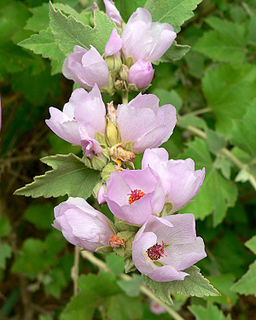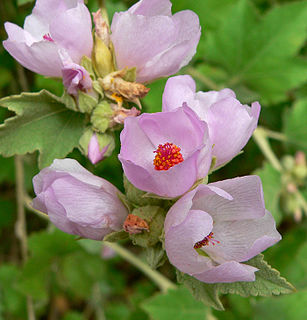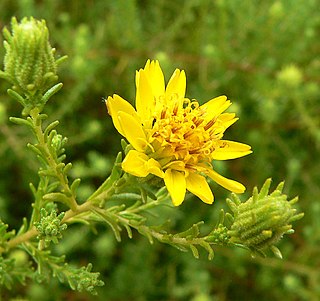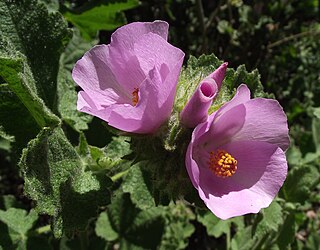
Astragalus lemmonii, the Lemmon's milkvetch, is a rare plant of eastern California. It is a member of the bean family, the Leguminosae, and specifically a member of the subfamily Papilionoideae. The genus Astragalus is a large genus within this family; members of this genus are known as milkvetches or locoweeds. Close relatives of this particular species include Astragalus peckii and Astragalus lentiformis.

Malacothamnus (bushmallow) is a genus of shrubs and subshrubs found throughout much of mainland California and on three of the Channel Islands. Outside of California, Malacothamnus is known from the northern half of Baja California, from a disjunct location in central Arizona, and possibly from a historic location that may have been in southern Arizona or adjacent Mexico. Plants of this genus are most commonly found in early-successional, post-burn plant communities. Malacothamnus are currently thought to be most closely related to the Iliamnas of the US interior and the Phymosias of Mexico, Central America, and the Caribbean.

Arctostaphylos glandulosa, with the common name Eastwood's manzanita, is a species of manzanita.

Limnanthes floccosa, or woolly meadowfoam, is a species of meadowfoam found in Northern California and Southern Oregon, in the United States. Most of the subspecies have highly restricted distributions and are listed as critical or endangered.

Harmonia stebbinsii is a species of flowering plant in the family Asteraceae known by the common name Stebbins' tarweed, or Stebbins' madia. It is endemic to northern California, where it is limited to the Klamath Mountains and adjacent slopes of the North Coast Ranges. It is a member of the serpentine soils plant community in these mountains, found at elevations of 1100–1600 meters. It is a rare annual herb producing a bristly stem up to about 25 centimeters tall studded with black resin glands. Its bristly leaves grow up to about 2 centimeters long and are mostly gathered near the base of the plant. The inflorescence is an array of flower heads lined with hairy, glandular, purple-tipped phyllaries. The head has a few yellow ray florets several millimeters long and yellow disc florets. The fruit is an achene tipped with a pappus.

Malacothamnus fasciculatus, with the common name chaparral mallow, is a species of flowering plant in the mallow family. It is found in far western North America.
Malacothamnus palmeri is a species of flowering plant in the mallow family known by the common names Cambria bushmallow and Palmer's bushmallow. It is endemic to San Luis Obispo County, California, where it is known from the Santa Lucia Mountains.

Cupressus stephensonii is a species of conifer known as the Cuyamaca cypress, and is endemic to Southern California. It has been classified as Hesperocyparis stephensonii. It was previously listed as Cupressus arizonica subsp. stephensonii and Cupressus arizonica var. glabra.

Sidalcea oregana is a species of flowering plant in the mallow family known by the common name Oregon checkerbloom.
Deinandra increscens is a species of flowering plant in the family Asteraceae known by the common name grassland tarweed. It is endemic to California, where it has been found primarily in Monterey, San Luis Obispo and Santa Barbara Counties. A few isolated populations have been reported from Kern and Merced Counties, but these are from urban areas and probably represent cultivated specimens.

Calochortus fimbriatus is a California species of flowering plant in the lily family known by the common name late-blooming mariposa lily. It is native to the coastal mountain ranges of southern Monterey, San Luis Obispo, Santa Barbara and northern Ventura counties, where it is a member of the chaparral flora.

Deinandra minthornii — — is a rare California species of flowering plant in the family Asteraceae known by the common name Santa Susana tarplant, or Santa Susana tarweed. It is an endangered species, listed as a Threatened species by the California Department of Fish and Game, as Imperiled under the California Endangered Species Act—CESA, and on the California Native Plant Society Inventory of Rare and Endangered Plants of California.

Castela emoryi, with the common names crucifixion thorn and Emory's crucifixion-thorn, is a shrub species in the genus Castela of the order Sapindales.

Malacothamnus lucianus is a species of flowering plant in the mallow family known by the common names Arroyo Seco bushmallow and Santa Lucia bushmallow and by the cultivar name Hanging Valley bushmallow. It is endemic to Monterey County, California, where it is known from the Santa Lucia Mountains.
Malacothamnus involucratus is a species of flowering plant in the mallow family known by the common name Carmel Valley bushmallow. It is likely endemic to Monterey County, California, where it is known from Carmel Valley and the Jolon region. A single specimen is attributed to San Luis Obispo County, California but the origin of this specimen is questionable.
Malacothamnus mendocinensis is a species of flowering plant in the mallow family known by the common name Mendocino bushmallow. It is endemic to Mendocino County, California, where it is known from only two populations. It has a California Rare Plant Rank of 1A. Malacothamnus mendocinensis is occasionally treated within Malacothamnus fasciculatus.
Malacothamnus parishii is a species of flowering plant in the mallow family known by the common name Parish's bushmallow. It is endemic to San Bernardino County, California, where it is confirmed from only a single collection from 1895. It has a California Rare Plant Rank of 1A. Malacothamnus parishii is occasionally treated within Malacothamnus fasciculatus.
Malacothamnus hallii is a species of flowering plant in the mallow family known by the common name Hall's bushmallow. It is endemic to southeastern counties of the San Francisco Bay Area, where it is a rare species. It has a California Rare Plant Rank of 1B.2. Malacothamnus hallii is occasionally treated within Malacothamnus fasciculatus.
Malacothamnus orbiculatus is a species of flowering plant in the mallow family known by the common names Tehachapi bushmallow and round-leaved bushmallow. It occurs in California, where it is common after burns on the desert-facing slopes of mountains, and Arizona, where it is currently only known from a few locations. Malacothamnus orbiculatus is occasionally treated within Malacothamnus fremontii.
Malacothamnus helleri is a species of flowering plant in the mallow family known by the common name Heller's bushmallow. It is endemic to Northern California, where it is a rare species. It has a California Rare Plant Rank of 3.3. Malacothamnus hellerii is occasionally treated within Malacothamnus fremontii.











